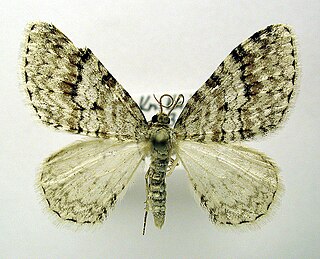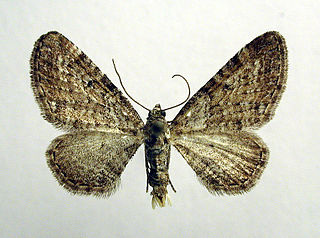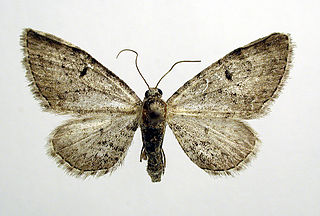
Eupithecia is the largest genus of moths of the family Geometridae, and the namesake and type genus of tribe Eupitheciini. Species in the genus are, like those of other genera in the tribe, commonly known as pugs. The genus is highly speciose, with over 1400 species, and members of the genus are present in most of the world with exception of Australasia. Roughly a quarter of described Eupithecia species occur in the Neotropical realm, where they have an especially high species diversity in the montane rain forests of the Andes. The genus includes a few agricultural pest species, such as the currant pug moth, Eupithecia assimilata, which is a pest on hops, and the cloaked pug moth, Eupithecia abietaria, which is a cone pest in spruce seed orchards.

The mottled pug is a moth of the family Geometridae. The species was first described by Jacob Hübner in 1813. It is found across the Palearctic region apart from around the Mediterranean Sea. It is common in the British Isles apart from Scotland where it is rather local.

The juniper pug or juniper looper is a moth of the family Geometridae. The species was first described by Michael Denis and Ignaz Schiffermüller in 1775. It is found throughout the Palearctic and in the Nearctic.

Venusia is a genus of moths in the family Geometridae erected by John Curtis in 1839.

Eupithecia pernotata, or Guenée's pug, is a moth of the family Geometridae. The species was first described by Achille Guenée in 1857. It is known from the Alps, through Romania to southern Russia. It is also found in Finland.

Eupithecia pimpinellata, the pimpinel pug, is a moth of the family Geometridae. The species was first described by Jacob Hübner in 1813. It is known from most of Europe to Morocco, Siberia, Kyrgyzstan, Altai, Mongolia.It primarily colonizes bushy places, forest edges, clearings, hedges, mountain slopes, embankments, railway dams and parks as well as semi-dry grasslands. In the Alps it rises to heights of 1800 metres.
Eupithecia acolpodes is a moth in the family Geometridae. It is found in India and Pakistan. Vladimir Mironov and Anthony Galsworthy place the species as part of the sinuosaria species group.
Eupithecia pertusata is a moth in the family Geometridae. It is found the United States in south-western Texas, Arizona and New Mexico.
Eupithecia sheppardata is a moth in the family Geometridae first described by James Halliday McDunnough in 1938. It is found in North America, including New Brunswick, Ontario, Quebec, Maine and New York.
Eupithecia prostrata is a moth in the family Geometridae. It is found in California and Arizona.
Eupithecia quercetica is a moth in the family Geometridae. It is found in Ukraine, Bulgaria, North Macedonia, Greece, Crete, Cyprus and the Near East.
Eupithecia bastelbergeri is a moth in the family Geometridae. It is found in Kazakhstan, Kyrghyzstan, Russia, Iran and Turkey.
Eupithecia scribai is a moth in the family Geometridae. It is found in the Russian Far East, Japan and Korea.

Eupithecia subbrunneata is a moth in the family Geometridae. It is found in China and Russia.
Eupithecia duena is a moth in the family Geometridae. It is found in Ecuador and Peru.
Eupithecia glaisi is a moth in the family Geometridae. It is found in Algeria.
Eupithecia junctifascia is a moth in the family Geometridae. It is found in Colombia and Costa Rica.
Eupithecia moricandiata is a moth in the family Geometridae. It is found in Algeria.
Eupithecia subflavolineata is a moth in the family Geometridae. It is found in Algeria.
Eupithecia tarfata is a moth in the family Geometridae. It is found in Algeria.






